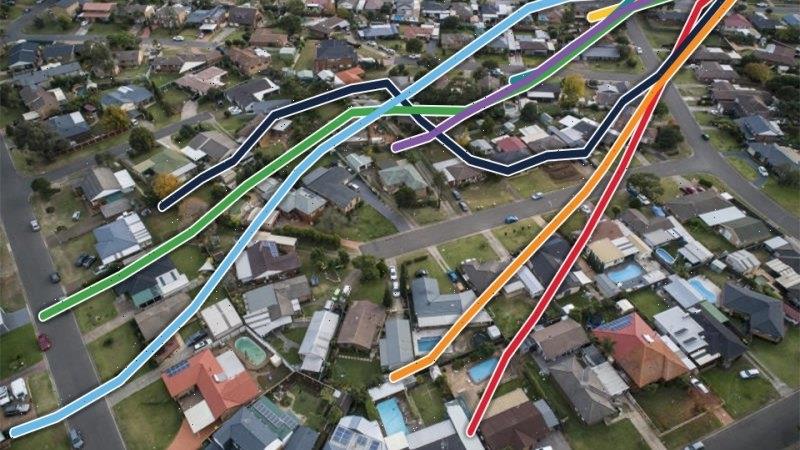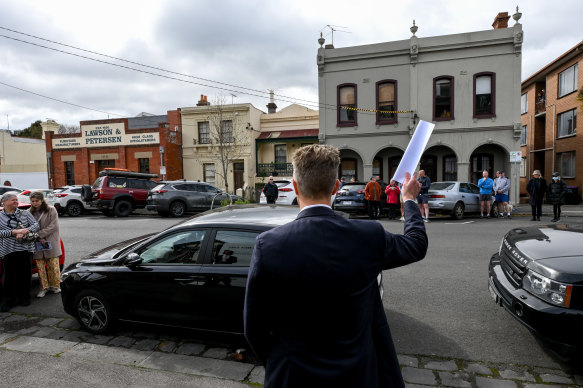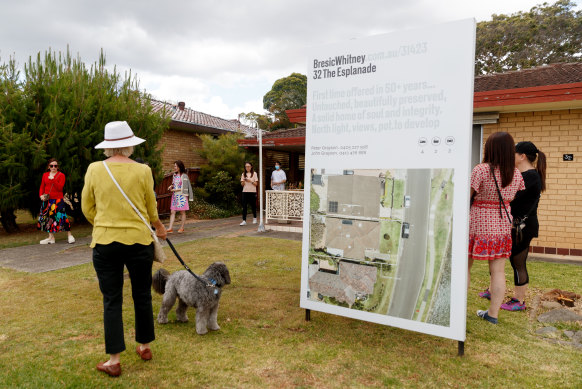Key points
- Australian property values posted a larger fall in the final nine months of 2022 than they did over 20 months in 2017-19.
- Sydney values are down 13 per cent, Brisbane 10 per cent and Melbourne 8.6 per cent.
- Because interest rates have a lagged effect, further falls in property values are likely.
Property listings
The Australian property market has notched its deepest downturn on record after national home values slumped 8.4 per cent since their peak, CoreLogic figures show, and experts warn more falls are yet to come.
The previous record downturn was the 8.38 per cent drop between October 2017 and June 2019, when the bank regulator clamped down on runaway lending to investors.
Property values have fallen at the fastest pace on record, CoreLogic figures show.Credit:Eddie Jim
This fall since the peak in May has been faster, taking less than nine months so far, after interest rates rose at the fastest pace on record.
The Reserve Bank lifted the cash rate from a rock-bottom 0.1 per cent in April last year to 3.1 per cent now, and signalled further hikes could be ahead. This prompted bank economists to forecast peak to trough property price falls between 15 per cent and 20 per cent.
CoreLogic head of Australian research Eliza Owen said the housing market is more sensitive to rate rises than in the past because households have more debt.
Housing debt sits at 188.5 per cent of incomes, on RBA figures, compared to less than 50 per cent in the 1990s, she said.
“A lot more people are going to be feeling the effects of higher interest rates,” she said.
“The fact that property prices have reacted so strongly is just another sign of how much more expensive housing is in 2023 – the fact that it’s had such a strong reaction to what would be a relatively low interest rate compared to the early 1990s.”
Sydney home values have fallen most in the downturn, dropping 13 per cent from their peak, while Brisbane values have fallen 10 per cent and Melbourne is down 8.6 per cent. In more affordable Perth, values have fallen less than 1 per cent.
The falls come after property prices boomed during the lockdown years as households armed with cheap loans searched for more spacious homes.
Home values jumped 28.9 per cent nationally between September 2020 and May 2022, the fastest rise on record, the research found.
Despite the recent falls, dwelling values remain 16.3 per cent higher than in March 2020 nationally. In Melbourne, which had more muted price gains as some residents moved away during the six lockdowns, values are now 1.4 per cent above their March 2020 level.
Owen said for recent home buyers, the falls are not significant unless they need to sell their property.
“If worse comes to worst and they need to sell their home to pay the debt, that could potentially create some risk of negative equity, but given that most mortgages were still going out on deposits of 20 per cent or more, that probably won’t be the case for the majority of people that have to sell,” she said.
Home values are tipped to keep falling as interest rates rise.Credit:Nikki Short
She expects home values to keep falling as the cash rate rises a little more this year, given interest rate rises often have a lagged effect.
“This could be the largest downturn on record by some margin,” she said. “This has come off a relatively large upswing.”
Among the major banks, Commonwealth Bank economists forecast a peak-to-trough price fall of 15 per cent across the capital cities, while Westpac expects a 16 per cent fall, and ANZ and NAB have pencilled in 18 per cent. AMP Capital expects a 15 per cent to 20 per cent fall.
CommSec chief economist Craig James said the deep falls illustrate that property prices are “very responsive” to interest rate changes, particularly when rates were significantly low and home prices were at record highs.
He expects home values to extend their declines this year from the 8.4 per cent fall so far to a 15 per cent peak-to-trough drop.
“The Reserve Bank has had to be very quick in lifting interest rates because the concern has been inflation could take a much more protracted hold on the economy,” he said.
He said the central bank would watch the property market’s effect on consumer spending. That includes borrowers on fixed rates whose mortgage repayments will increase, and who will be forced to decide how much they can afford to spend on other items.
“When people see their home prices easing, that can have potential negative wealth effects – so you can get potentially more recent buyers see the value of their home fall below what they ended up paying for it, and that affects them in terms of what they’re able to spend,” he said.
AMP Capital chief economist Dr Shane Oliver expects the record decline in values to continue until a few months after the cash rate stops rising.
“Top to bottom we’re looking at a fall of 15 to 20 per cent,” he said. “We’re about halfway through at present.
“We have more downside to come because the impact of higher interest rates is still flowing through.”
Rising rates had the largest effect on buying power, Oliver said, but a confluence of other factors also contributed to the speed of the decline.
“There was a massive boom at the end of last year, property had become very unaffordable, household debt levels have become very high and now we have a situation where interest rates have surged,” he said.
“Combine that with high debt levels and it’s a clear recipe for falling prices.”
He said some mortgage holders whose fixed-rate terms end may not be able to service their debt, leading to an increase in distressed selling.
Anyone who fixed their rate at about 2 per cent could expect an increase to 5 to 6 per cent, Oliver said.
The most recent downturn was more widespread than the 2017-19 price falls, which were largely confined to major cities. This was because a pandemic-induced shift in buyer preference towards regional property and larger houses was reversing, he said.
Most Viewed in Property
Source: Read Full Article


